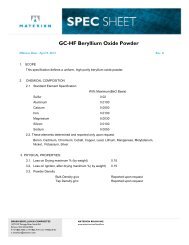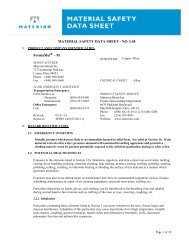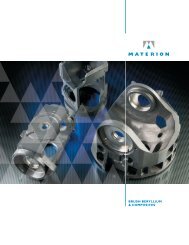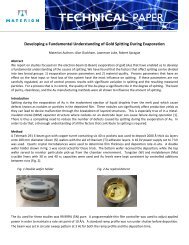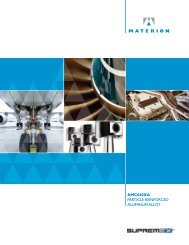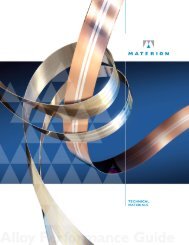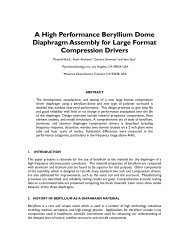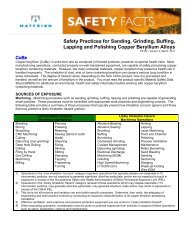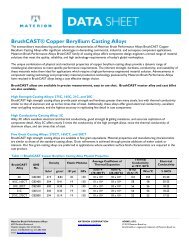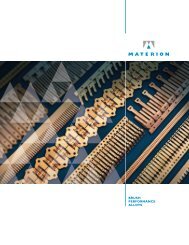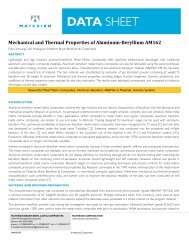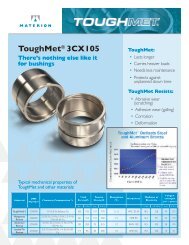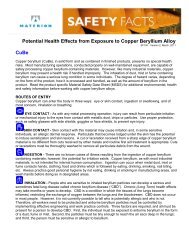Use of Aluminum-Beryllium Composites ON the ... - Materion
Use of Aluminum-Beryllium Composites ON the ... - Materion
Use of Aluminum-Beryllium Composites ON the ... - Materion
Create successful ePaper yourself
Turn your PDF publications into a flip-book with our unique Google optimized e-Paper software.
<strong>Use</strong> <strong>of</strong> <strong>Aluminum</strong>-<strong>Beryllium</strong> <strong>Composites</strong> <strong>ON</strong> <strong>the</strong> ORBCOMM Satellite<br />
Tom Dragone-Orbital Sciences, Tom Parsonage, <strong>Materion</strong> Brush <strong>Beryllium</strong> and <strong>Composites</strong>, Rob Hardesty, Peregrine Falcon<br />
ABSTRACT<br />
Newly developed metal matrix composites <strong>of</strong> aluminum and beryllium (Al-Be) have been used in <strong>the</strong> primary<br />
structure <strong>of</strong> Orbital Sciences Corporation's ORBCOMM communication satellites. Hot Isostatically Pressed and<br />
extruded Al-Be materials used in <strong>the</strong>se spacecraft have a two-phase microstructure that combines <strong>the</strong> stiffness and<br />
light-weight <strong>of</strong> beryllium with <strong>the</strong> ductility and fabrication ease <strong>of</strong> aluminum and <strong>the</strong> synergistic streng<strong>the</strong>ning effect <strong>of</strong><br />
<strong>the</strong> dual phases. The ORBCOMM spacecraft has undergone a rigorous qualification testing program that included<br />
modal identification (to verify structural stiffness), ultimate static loading, vibration testing to levels typical <strong>of</strong> a Pegasus<br />
launch, separation shock loading to over 600 g's at greater than 1000 Hz, and <strong>the</strong>rmal cycling between -35°C and<br />
+40°C. The aluminum-beryllium composite structure survived <strong>the</strong>se environments with no cracking, no detrimental<br />
permanent deformation, and no degradation in material properties. Fur<strong>the</strong>rmore, <strong>the</strong> first two ORBCOMM satellites<br />
have been launched into low earth orbit by OSC's Pegasus launch vehicle, and have been operating for over a year.<br />
This paper will fur<strong>the</strong>r describe <strong>the</strong> spacecraft structure, design drivers that led to <strong>the</strong> selection <strong>of</strong> this material, its<br />
fabrication process, results <strong>of</strong> qualification testing, and a cost comparison to o<strong>the</strong>r materials.<br />
Keywords: Metal Matrix <strong>Composites</strong>, <strong>Aluminum</strong>-<strong>Beryllium</strong>, AlBeMet, Space Applications, Structures<br />
INTRODUCTI<strong>ON</strong><br />
Looking for better and less costly methods <strong>of</strong> sending satellites into orbit is keeping material’s scientists and<br />
metallurgists on a never-ending quest: finding metals and alloys that <strong>of</strong>fer a combination <strong>of</strong> high strength, light weight,<br />
rigidity, and <strong>the</strong> ability to be fabricated into shapes and sizes to suit <strong>the</strong> application. Conventional metals, alloys, and<br />
some composites <strong>of</strong>ten don't have <strong>the</strong> properties to meet <strong>the</strong>se demanding requirements. AlBeMet ® , a metal matrix<br />
composite <strong>of</strong> aluminum and beryllium, combines <strong>the</strong> high modulus and low density <strong>of</strong> beryllium with <strong>the</strong> strength,<br />
ductility, and fabrication characteristics <strong>of</strong> aluminum. The composites promise to fulfill many <strong>of</strong> <strong>the</strong> needs <strong>of</strong> satellites<br />
and o<strong>the</strong>r spacecraft structures.<br />
AlBeMet ® composites produced by <strong>Materion</strong> Brush <strong>Beryllium</strong> & <strong>Composites</strong> are being used for <strong>the</strong> major structural<br />
components <strong>of</strong> a satellite system being produced by Orbital Sciences Corporation (OSC). The initial system is<br />
expected to consist <strong>of</strong> a constellation <strong>of</strong> 28 small satellites in low earth orbit that will provide seamless, two-way,<br />
real-time messaging between any two points on <strong>the</strong> globe. In addition, with sophisticated global positioning system<br />
navigation technology, users will be able to accurately determine <strong>the</strong>ir position or that <strong>of</strong> <strong>the</strong>ir remotely located<br />
assets. Stranded boaters or hikers can send highly accurate position information to rescuers. Mobile equipment<br />
owners can monitor locations <strong>of</strong> all vehicles in a fleet <strong>of</strong> trucks, ships, or railroad cars with <strong>the</strong> ORBCOMM satellite<br />
system. Farmers can effectively manage large irrigation systems by monitoring temperature, water pressure and o<strong>the</strong>r<br />
parameters important to <strong>the</strong> irrigation program.<br />
The first two ORBCOMM satellites were launched in April, 1995 on a Pegasus small launch vehicle. The satellites<br />
became fully operational a few months later and limited service has already begun. Full service, with complete global<br />
coverage is scheduled for early in 1997 with three more Pegasus launches, each consisting <strong>of</strong> eight ORBCOMM<br />
spacecraft stacked on top <strong>of</strong> one ano<strong>the</strong>r.<br />
MAAB-002<br />
BRUSH BERYLLIUM AND COMPOSITES<br />
MATERI<strong>ON</strong> CORPORATI<strong>ON</strong><br />
14710 W Portage River South Rd www.materion.com/beryllium<br />
Elmore, OH 43416-9502<br />
P: +1 419.962.4533 or +1 419.862.4171 intl +1 419.862.4127<br />
Info: berylliumandcomposites@materion.com<br />
© <strong>Materion</strong> Corporation
SPACECRAFT C<strong>ON</strong>FIGURATI<strong>ON</strong><br />
With <strong>the</strong> exception <strong>of</strong> <strong>the</strong> first two spacecraft, each <strong>of</strong> <strong>the</strong> 28 spacecraft in <strong>the</strong> ORBCOMM constellation is planned<br />
to be identical and to consist <strong>of</strong> three major components identified in Figure 1 in <strong>the</strong> deployed configuration:<br />
A flat 1.04 m (41 in) diameter by 152.5 mm (6 in) high housing that contains <strong>the</strong> spacecraft's computers, attitude<br />
control system, propulsion system, and communications payload<br />
<br />
<br />
Two deployable, articulated solar panels for providing power to <strong>the</strong> spacecraft<br />
A segmented, deployable boom supporting <strong>the</strong> subscriber, UHF, and gateway antennas for communication with<br />
<strong>the</strong> ground<br />
For launch, <strong>the</strong> solar panels and <strong>the</strong> antenna boom are folded into <strong>the</strong> spacecraft structure, allowing multiple<br />
spacecraft to be stacked on top <strong>of</strong> each o<strong>the</strong>r. Non-explosive separation bolts attach <strong>the</strong> spacecraft to each o<strong>the</strong>r at<br />
three points on <strong>the</strong> interface.<br />
The primary spacecraft ring consists <strong>of</strong> three arched 25 mm (1 in) thick AlBeMet ® sandwich panels fastened toge<strong>the</strong>r<br />
by three AlBeMet ® separation brackets. The brackets incorporate 12.5 mm (0.5 in) thick upper and lower flanges to<br />
hold <strong>the</strong> separation bolts and <strong>the</strong> shear bearings to provide a stiff load path between spacecraft structures when <strong>the</strong>y<br />
are stacked toge<strong>the</strong>r for launch. Four dip-brazed vertical gusset panels connect <strong>the</strong> upper and lower flanges to<br />
provide a rigid structure that also allows access to <strong>the</strong> separation bolts during spacecraft integration. The outer two<br />
vertical gussets are machined into C-channels to accommodate <strong>the</strong> arched ring segments that are both bonded and<br />
riveted into <strong>the</strong> channels. Brazed AlBeMet ® brackets connect payload shelf to <strong>the</strong> primary spacecraft ring. Since <strong>the</strong><br />
payload mounting shelf is not in <strong>the</strong> primary stiffness path <strong>of</strong> <strong>the</strong> stacked configuration, it can be fabricated from<br />
standard aluminum. Bonded AlBeMet ® pieces are also needed for <strong>the</strong> rectangular tube used as <strong>the</strong> support structure<br />
for <strong>the</strong> antenna boom segments.<br />
Figure 1 – ORBCOMM Spacecraft Configuration<br />
ORBCOMM Assembly<br />
DISCUSSI<strong>ON</strong><br />
Design Requirements. The design <strong>of</strong> <strong>the</strong> ORBCOMM spacecraft and <strong>the</strong> choice <strong>of</strong> its materials was ultimately driven<br />
by <strong>the</strong> requirement to survive all launch vehicle imposed loads (1) with <strong>the</strong> minimum weight possible. From this<br />
system-level requirement, material requirements for stiffness, strength, and ductility were derived.<br />
MAAB-002<br />
BRUSH BERYLLIUM AND COMPOSITES<br />
MATERI<strong>ON</strong> CORPORATI<strong>ON</strong><br />
14710 W Portage River South Rd www.materion.com/beryllium<br />
Elmore, OH 43416-9502<br />
P: +1 419.962.4533 or +1 419.862.4171 intl +1 419.862.4127<br />
Info: berylliumandcomposites@materion.com<br />
© <strong>Materion</strong> Corporation
Stiffness Requirements. To reduce <strong>the</strong> magnitude <strong>of</strong> <strong>the</strong> dynamic transient loads accompanying <strong>the</strong> launch and to avoid<br />
launch vehicle guidance problems, <strong>the</strong> combined stack <strong>of</strong> eight ORBCOMM satellites is required to have a bending<br />
frequency <strong>of</strong> no less than 20 Hz. In addition, under dynamic loading, <strong>the</strong> maximum deflection at <strong>the</strong> top <strong>of</strong> <strong>the</strong> stack <strong>of</strong><br />
eight satellites can be no greater than 6.3 mm (0.25 in) to avoid violating <strong>the</strong> Pegasus fairing envelope.<br />
Both <strong>of</strong> <strong>the</strong>se requirements result in <strong>the</strong> need for high stiffness, as measured ei<strong>the</strong>r by <strong>the</strong> natural vibration frequency<br />
(proportional to [EI/M ½ ] or by deflection (proportional to 1/EI). Since <strong>the</strong> geometric stiffness (i.e. effective inertia, I,<br />
for <strong>the</strong> stacked configuration) is limited by <strong>the</strong> available payload fairing diameter and is fur<strong>the</strong>r compromised by <strong>the</strong><br />
added compliance <strong>of</strong> joints between spacecraft, a high intrinsic stiffness (i.e. modulus, E) is required. Initial stiffness<br />
sizing performed by OSC indicated that a modulus value higher than that <strong>of</strong> aluminum, greater than 69 GPa (10 Msi),<br />
would be required.<br />
Strength Requirements. In addition to needing maximum rigidity in <strong>the</strong> satellite stack, <strong>the</strong> high loads resulting from <strong>the</strong><br />
Pegasus launch transient mean that a high strength material is needed for <strong>the</strong> spacecraft construction as well. Initial<br />
sizing analyses conducted by OSC indicated that yield values at least as high as those <strong>of</strong> 6061 aluminum, 273 MPa (40<br />
ksi) or higher, would be required. In particular, high loads were expected for <strong>the</strong> flange pieces which support both <strong>the</strong><br />
preload forces from <strong>the</strong> separation bolts and <strong>the</strong> dynamic bending loads associated with launch.<br />
Ductility Requirements. Although non-explosive separation bolts are used to connect <strong>the</strong> spacecraft toge<strong>the</strong>r in <strong>the</strong><br />
launch configuration, shock loads at <strong>the</strong> interface are high because a significant amount <strong>of</strong> stored strain energy in <strong>the</strong><br />
preloaded bolts is released within a few milliseconds when separation is initiated. Therefore, brittleness was a concern<br />
in <strong>the</strong> design and material selection for <strong>the</strong> spacecraft. The dynamic nature <strong>of</strong> <strong>the</strong> shock loading could not be easily<br />
correlated to crack growth rates or material strength, so no requirement for fracture toughness could be derived<br />
from <strong>the</strong> loading. Instead, a substantial ductility, as evidenced by elongation to failure greater than 5%, was deemed<br />
indicative <strong>of</strong> sufficient resistance to shock loading and was desired for <strong>the</strong> materials selected for <strong>the</strong> spacecraft.<br />
Materials Selection. Initially, aluminum was considered for <strong>the</strong> primary spacecraft ring and bracket structure, but<br />
aluminum options could not meet <strong>the</strong> stiffness requirements within <strong>the</strong> allowable mass budget. Magnesium provided<br />
only a marginally stiffer structure for <strong>the</strong> same weight. A more costly beryllium structure could easily have met <strong>the</strong><br />
stiffness requirements (with over six times <strong>the</strong> specific stiffness <strong>of</strong> aluminum), but beryllium presented considerable<br />
problems for <strong>the</strong> shock and dynamic loading because <strong>of</strong> its brittleness.<br />
A unidirectional graphite/epoxy structure could be fabricated with high modulus fibers and result in a specific stiffness<br />
<strong>of</strong> over five times that <strong>of</strong> aluminum, but such a structure would also result in highly anisotropic properties. The<br />
ORBCOMM ring structure requires both hoop and shear stiffness to resist bending <strong>of</strong> <strong>the</strong> satellite stack; <strong>the</strong> specific<br />
stiffness <strong>of</strong> a composite layup tailored to <strong>the</strong>se requirements would be reduced to less than twice that <strong>of</strong> aluminum.<br />
Fur<strong>the</strong>rmore, <strong>the</strong> ORBCOMM separation brackets require thick sections and nearly isotropic properties to resist <strong>the</strong><br />
separation bolt preload forces. Consequently, <strong>the</strong>re was significant concern about <strong>the</strong> ability to fabricate a<br />
graphite/epoxy composite into this configuration easily.<br />
AlBeMet ® composites ultimately provided <strong>the</strong> unique combination <strong>of</strong> stiffness, strength, and high ductility along with<br />
light weight that met all <strong>the</strong> ORBCOMM structure requirements. With a modulus in <strong>the</strong> range <strong>of</strong> 145-180 GPa (21-26<br />
Msi) and a density in <strong>the</strong> range <strong>of</strong> 2.1-2.26 g/cc (0.076-0.082 lbm/in 3 ) AlBeMet ® has a specific stiffness that is 2.5 to 3.5<br />
MAAB-002<br />
BRUSH BERYLLIUM AND COMPOSITES<br />
MATERI<strong>ON</strong> CORPORATI<strong>ON</strong><br />
14710 W Portage River South Rd www.materion.com/beryllium<br />
Elmore, OH 43416-9502<br />
P: +1 419.962.4533 or +1 419.862.4171 intl +1 419.862.4127<br />
Info: berylliumandcomposites@materion.com<br />
© <strong>Materion</strong> Corporation
that <strong>of</strong> aluminum. More importantly, <strong>the</strong> stiffness is isotropic, and ideally suited to <strong>the</strong> requirements <strong>of</strong> <strong>the</strong><br />
ORBCOMM primary structure. AlBeMet's two-phase microstructure, shown in Figure 2, consists <strong>of</strong> elongated discrete<br />
or semi-continuous beryllium particles within a continuous aluminum matrix. Due to <strong>the</strong> mutual insolubility <strong>of</strong> <strong>the</strong> two<br />
phases in each o<strong>the</strong>r, <strong>the</strong> microstructure is quite stable, and little noticeable change can be observed after heat<br />
treatment (2).<br />
Figure 2 – AlBeMet ® microstructure showing semi-continuous beryllium phase (dark) within continuous aluminum phase (light).<br />
Bars indicate 100µm (left) and 10µm (right).<br />
The material can be characterized as an engineered composite material because <strong>of</strong> <strong>the</strong> potential synergistic<br />
combination <strong>of</strong> beryllium's high modulus and load bearing capability with aluminum's toughness and ductility. For<br />
example, strength <strong>of</strong> some AlBeMet ® composite materials is higher than that <strong>of</strong> ei<strong>the</strong>r <strong>of</strong> <strong>the</strong> parent metals because <strong>of</strong><br />
<strong>the</strong> nature <strong>of</strong> <strong>the</strong> load sharing between <strong>the</strong> two phases and <strong>the</strong> impedance to dislocation motion and plastic flow<br />
presented by <strong>the</strong> phase boundaries. Strength and elongation properties <strong>of</strong> AlBeMet ® composites are compared with<br />
those properties <strong>of</strong> 6061 aluminum and pure beryllium in Figure 3.<br />
As in most composite systems, AlBeMet's atomic-based properties like density, modulus and coefficient <strong>of</strong> <strong>the</strong>rmal<br />
expansion follow <strong>the</strong> Rule <strong>of</strong> Mixtures averaging, with properties varying monotonically with <strong>the</strong> proportion <strong>of</strong><br />
constituent phases. Modulus and coefficient <strong>of</strong> <strong>the</strong>rmal expansion (CTE) values for AlBeMet ® are shown in Figure 4.<br />
In addition to <strong>the</strong> stiffness and strength advantages that AlBeMet ® has over aluminum, it also provides improved<br />
<strong>the</strong>rmal properties as well. In particular, AlBeMet's <strong>the</strong>rmal expansion coefficient is up to 40% lower than that <strong>of</strong><br />
aluminum, resulting in lower <strong>the</strong>rmally induced stresses and deflections. This property was <strong>of</strong> particular importance in<br />
<strong>the</strong> selection <strong>of</strong> a material for <strong>the</strong> ORBCOMM antenna boom. In this structure, <strong>the</strong> use <strong>of</strong> AlBeMet ® significantly<br />
decreased <strong>the</strong> <strong>the</strong>rmally induced deformation <strong>of</strong> <strong>the</strong> boom, and provided greater antenna accuracy.<br />
MAAB-002<br />
BRUSH BERYLLIUM AND COMPOSITES<br />
MATERI<strong>ON</strong> CORPORATI<strong>ON</strong><br />
14710 W Portage River South Rd www.materion.com/beryllium<br />
Elmore, OH 43416-9502<br />
P: +1 419.962.4533 or +1 419.862.4171 intl +1 419.862.4127<br />
Info: berylliumandcomposites@materion.com<br />
© <strong>Materion</strong> Corporation
Figure 3. Comparisons <strong>of</strong> typical strength and<br />
elongation to failure for 6061 aluminum, AlBeMet ® and<br />
pure beryllium.<br />
Figure 4. Modulus and Coefficient <strong>of</strong> Thermal Expansion<br />
(CTE) as a function <strong>of</strong> beryllium content for aluminum<br />
beryllium materials.<br />
AlBeMet ® grades 150 and 162 (corresponding to 50 wt% and 62 wt% Be respectively) were chosen for <strong>the</strong><br />
ORBCOMM structures because <strong>the</strong>y are nearly as stiff as steel (E = 145-180 GPa or 21-26 Msi), lighter than<br />
aluminum (p ≡ 2.19 g/cc or 0.079 lbm/in 3 ) and less costly than pure beryllium. The AlBeMet ® 162 grade is more<br />
completely characterized (3, 4), and was specified for <strong>the</strong> critical components in <strong>the</strong> ORBCOMM spacecraft – <strong>the</strong><br />
separation brackets and <strong>the</strong> payload deck brackets. These structures demanded <strong>the</strong> higher strength that <strong>the</strong> 162<br />
grade could provide. Mechanical properties <strong>of</strong> <strong>the</strong> hot isostatically pressed (HIP'd), extruded, and cross-rolled sheet<br />
<strong>of</strong> AlBeMet ® 162 are listed in Table l. In <strong>the</strong> formed and heat treated condition, nearly isotropic strength was<br />
attainable with sufficient ductility (greater than 6%) to indicate that brittleness would not be a major concern. The<br />
less-demanding structures – face sheets for <strong>the</strong> honeycomb panels <strong>of</strong> <strong>the</strong> spacecraft ring and <strong>the</strong> antenna boom – are<br />
fabricated from <strong>the</strong> 150 grade. The honeycomb itself is 5052 aluminum.<br />
Table 1. Typical Properties <strong>of</strong> AlBeMet ® 162 in <strong>the</strong> HIP’d, Extruded or Rolled Condition.<br />
Alloy Condition Heat Treatment Yield Strength MPa<br />
(ksi)<br />
Ultimate Strength<br />
MPa (ksi)<br />
HIP’d None 242 (35.1) 306 (44.4) 2.56<br />
593 o C/24 hr 433 (32.8) 287 (41.6) 2.71<br />
Extruded-L None 562 (81.5) 609 (88.4) 1.44<br />
593 o C/24 hr 328 (47.6) 439 (63.7) 9.40<br />
Extruded-T None 558 (81.0) 607 (88.1) 0.24<br />
593 o C/24 hr 314 (45.6) 345 (50.0) 6.12<br />
Rolled-L None 399 (57.8) 463 (67.2) 5.09<br />
593 o C/24 hr 314 (45.5) 413 (59.9) 7.75<br />
Rolled-T None 374 (54.3) 453 (65.7) 2.62<br />
593 o C/24 hr 319 (46.3) 406 (58.9) 6.39<br />
L=Longitudinal to work direction T=Transverse to work direction<br />
Elongation %<br />
MAAB-002<br />
BRUSH BERYLLIUM AND COMPOSITES<br />
MATERI<strong>ON</strong> CORPORATI<strong>ON</strong><br />
14710 W Portage River South Rd www.materion.com/beryllium<br />
Elmore, OH 43416-9502<br />
P: +1 419.962.4533 or +1 419.862.4171 intl +1 419.862.4127<br />
Info: berylliumandcomposites@materion.com<br />
© <strong>Materion</strong> Corporation
Fabrication. Fabricating AlBeMet ® materials is quite similar to fabricating aluminum. The principal fabrication difference<br />
is <strong>the</strong> need for a facility that can handle beryllium-containing materials to remove <strong>the</strong> fine, airborne beryllium particles<br />
that could pose a health risk to some people. Forming is also similar to aluminum production in that <strong>the</strong> same tooling<br />
and temperature ranges can usually be used for forming at an elevated temperature, typically over 200°C (400°F).<br />
Forming rate is slightly slower for <strong>the</strong> AlBeMet ® materials if severe deformation or bending is required. Gentle curves<br />
such as those <strong>of</strong> <strong>the</strong> ORBCOMM honeycomb ring panels were formed at <strong>the</strong> same rate as that used for aluminum<br />
panels.<br />
Coating. Like aluminum, <strong>the</strong> AlBeMet ® materials form a protective oxide film on freshly machined surfaces, except <strong>the</strong><br />
film on AlBeMet ® is much more tenacious. For this reason, immediate coating after machining or grinding parts is<br />
critical. Coating <strong>the</strong> AlBeMet ® surface resists corrosion and also provides a continuous bonding surface. Precleaning<br />
and proper coating application are critical for <strong>the</strong> primer, usually a phenolic-based epoxy compound, that is<br />
subsequently cured at 120°C (250°F).<br />
Once <strong>the</strong> machined surfaces are stabilized by coating, coated parts may be stored for months, if necessary. After<br />
storage, a simple alcohol wipe removes any dust or fingerprints prior to fur<strong>the</strong>r assembly operations. A quality<br />
fabricator can <strong>the</strong>refore furnish <strong>the</strong> product in a condition that <strong>the</strong> assembler/customer does not have to interface<br />
with <strong>the</strong> AlBeMet ® materials in his subsequent assembly or mounting operations.<br />
Joining. The AlBeMet ® materials can be joined by both electron beam welding and dip brazing methods. For <strong>the</strong><br />
ORBCOMM spacecraft structure, brazing was chosen because <strong>of</strong> consistency and quality <strong>of</strong> <strong>the</strong> joints. Expert<br />
fabricators <strong>of</strong> AlBeMet ® materials, such as Peregrine Falcon Corp., have developed proprietary programs involving<br />
higher temperatures and longer times <strong>the</strong>n those used for aluminum to obtain high-quality brazed joints.<br />
Design <strong>of</strong> joints for this metal matrix composite is quite different from those used for aluminum. <strong>Aluminum</strong> usually fails<br />
in a ductile manner, so bending occurs before failure, which usually occurs in <strong>the</strong> joint. With AlBeMet ® materials, <strong>the</strong><br />
metal is stiffer, so <strong>the</strong> joint is designed so <strong>the</strong> parent metal breaks before <strong>the</strong> joint fails. In this fail-safe design, <strong>the</strong><br />
joints are not <strong>the</strong> weak members in <strong>the</strong> design and will <strong>the</strong>refore take <strong>the</strong> stress build-up without failing.<br />
Testing. Exhaustive testing <strong>of</strong> <strong>the</strong> ORBCOMM spacecraft structures was conducted by simulating all flight loads for all<br />
critical components including <strong>the</strong> separation event. These tests included modal identification testing, axial and lateral<br />
static loading conditions, anticipated axial and lateral vibration, shock loads, and <strong>the</strong>rmal cycling loads.<br />
Modal testing identified all <strong>the</strong> significant mode shapes and natural frequencies <strong>of</strong> <strong>the</strong> ORBCOMM spacecraft, and<br />
verified <strong>the</strong> in-situ stiffness <strong>of</strong> <strong>the</strong> AlBeMet ® material. Modal properties agreed with predicted values and indicated that<br />
with AlBeMet ® , <strong>the</strong> stacked spacecraft would have a natural frequency <strong>of</strong> 21Hz, meeting <strong>the</strong> 20Hz minimum<br />
requirement. In addition, <strong>the</strong> modal testing verified deflection analysis that indicated that <strong>the</strong> satellite stack would not<br />
violate <strong>the</strong> Pegasus fairing dynamic envelope.<br />
Static load simulation <strong>of</strong> <strong>the</strong> launch environments was achieved using hydraulic actuators within a static loads test<br />
stand. Some <strong>of</strong> <strong>the</strong> recorded stresses for <strong>the</strong> separation transient lateral load case are shown in Figure 5. A peak stress<br />
<strong>of</strong> 300 MPa (43.9 ksi) was recorded in <strong>the</strong> lower flange under ultimate loading, resulting in a margin <strong>of</strong> safety <strong>of</strong> 0.45,<br />
based on UTS for <strong>the</strong> extruded bracket in <strong>the</strong> longitudinal direction (5). Slightly lower stresses were recorded in <strong>the</strong><br />
ring panels and vertical gussets. Despite <strong>the</strong> nonlinear stress increase due to complex load<br />
MAAB-002<br />
BRUSH BERYLLIUM AND COMPOSITES<br />
MATERI<strong>ON</strong> CORPORATI<strong>ON</strong><br />
14710 W Portage River South Rd www.materion.com/beryllium<br />
Elmore, OH 43416-9502<br />
P: +1 419.962.4533 or +1 419.862.4171 intl +1 419.862.4127<br />
Info: berylliumandcomposites@materion.com<br />
© <strong>Materion</strong> Corporation
transfer through <strong>the</strong> brackets, upon removal<br />
<strong>of</strong> <strong>the</strong> loads, stresses returned to <strong>the</strong>ir initial<br />
values indicating that no yielding or<br />
permanent deformation had occurred.<br />
Figure 5. Measured Von Misses stresses in <strong>the</strong> ORBCOMM separation bracket<br />
flange, cylindrical ring, and separation bracket gusset during simulated launch static<br />
loads testing.<br />
Random vibration testing was conducted<br />
over <strong>the</strong> range from 20 Hz to 2000 Hz in<br />
both <strong>the</strong> spacecraft axial and lateral<br />
directions. Typical results for an<br />
accelerometer placed on <strong>the</strong> payload shelf<br />
are shown in Figure 6. Resonance from <strong>the</strong><br />
spacecraft's payload shelf diaphragm mode is<br />
clearly seen at 70 Hz, but at higher<br />
frequencies, <strong>the</strong> measured vibration levels are<br />
lower than <strong>the</strong> input levels.<br />
This phenomenon was observed in most <strong>of</strong> <strong>the</strong> vibration responses and may indicate that <strong>the</strong> AlBeMet ® composite<br />
material is providing a measure <strong>of</strong> internal damping to reduce <strong>the</strong> vibration (6).<br />
Figure 6. Axial vibration response power spectral density<br />
at <strong>the</strong> ORBCOMM spacecraft payload shelf center under<br />
axial excitation.<br />
Figure 7. Accelerometer response at <strong>the</strong> ORBCOMM spacecraft<br />
separation bracket flange during separation shock loading.<br />
Shock loading <strong>of</strong> <strong>the</strong> spacecraft was accomplished by simultaneously releasing <strong>the</strong> three separation bolts that connect<br />
two spacecraft and recording <strong>the</strong> resulting accelerations at <strong>the</strong> separation bracket flanges and at o<strong>the</strong>r locations on <strong>the</strong><br />
spacecraft. While <strong>the</strong> release mechanism is non-explosive, shock levels are still high because <strong>of</strong> <strong>the</strong> stored strain energy<br />
in <strong>the</strong> bolts and in <strong>the</strong> brackets due to <strong>the</strong> preloading <strong>of</strong> <strong>the</strong> separation bolts. Typical accelerometer measurements at<br />
<strong>the</strong> separation bracket flange are shown in Figure 7. A peak acceleration <strong>of</strong> 600 g's was recorded at a frequency <strong>of</strong><br />
about 1000 Hz. Despite this very high acceleration, this short duration shock pulse did not appear to affect <strong>the</strong><br />
AlBeMet ® material in any way. Even after repeated separation tests, no cracks were observed in <strong>the</strong> separation bracket<br />
flanges or vertical gussets originating with <strong>the</strong> shock loading. The strength and load bearing capacity <strong>of</strong> <strong>the</strong> AlBeMet ®<br />
composite did not seem to be compromised ei<strong>the</strong>r, since no yielding or permanent deformation was observed during<br />
subsequent bolt preloading or fur<strong>the</strong>r static loads testing.<br />
MAAB-002<br />
BRUSH BERYLLIUM AND COMPOSITES<br />
MATERI<strong>ON</strong> CORPORATI<strong>ON</strong><br />
14710 W Portage River South Rd www.materion.com/beryllium<br />
Elmore, OH 43416-9502<br />
P: +1 419.962.4533 or +1 419.862.4171 intl +1 419.862.4127<br />
Info: berylliumandcomposites@materion.com<br />
© <strong>Materion</strong> Corporation
Thermal cycle qualification testing was conducted for twenty cycles over <strong>the</strong> range <strong>of</strong> -35°C (-31°F) to +40°C (104°F)<br />
with dwell times <strong>of</strong> over 1 hour at each end <strong>of</strong> <strong>the</strong> cycle. No detrimental deformation or material behavior was<br />
observed during this testing.<br />
Cost Comparison. Based on <strong>Materion</strong> Brush <strong>Beryllium</strong> & <strong>Composites</strong> metrics for <strong>the</strong> fabricated material, AlBeMet ®<br />
provides about 75% <strong>of</strong> <strong>the</strong> properties <strong>of</strong> beryllium at about one half <strong>the</strong> price. A more specific comparison can be made<br />
for <strong>the</strong> finished structure, including machining and post-fabrication costs based on OSC data. Besides <strong>the</strong> ORBCOMM<br />
spacecraft, OSC designed, built, tested, and launched ano<strong>the</strong>r spacecraft (called MicroLab) using <strong>the</strong> same general<br />
structural arrangement (ring structure, separation brackets, deployable solar panels, and deployable antenna boom).<br />
Although <strong>the</strong> payload was different (a optical sensor for a scientific experiment), MicroLab was also launched on<br />
Pegasus and was subjected to <strong>the</strong> same launch environments as <strong>the</strong> ORBCOMM spacecraft. However, separate<br />
constraints on <strong>the</strong> schedule and <strong>the</strong> payload led to <strong>the</strong> selection <strong>of</strong> magnesium for its primary structure. The two<br />
spacecraft primary structures are compared in Table 2. For a given weight <strong>of</strong> finished structure, <strong>the</strong> AlBeMet ®<br />
structure is three times stiffer than <strong>the</strong> magnesium structure (per pound <strong>of</strong> material) at only slightly over 25% higher<br />
unit cost. In <strong>the</strong> demanding satellite market, this performance is well worth <strong>the</strong> slight additional cost.<br />
Table 2. Comparison <strong>of</strong> cost and properties for ORBCOMM and MicroLab structures.<br />
Spacecraft Unit ORBCOMM Microlab<br />
Material AlBeMet ® Magnesium<br />
Cost* $ $23,000 $30,000<br />
Weight Kg (Lab) 4.54 (10.0) 7.62 (16.8)<br />
Unit Cost $/Kg ($/Lb) 5000 (2300) 4000 (1800)<br />
Modulus Gap (Msi) 158 (23) 43.4 (6.3)<br />
Density g/cc (Lbm/in 3 ) 2.1 (0.079) 1.7 (0.065)<br />
Specific Stiffness 10 6 m (10 6 in) 7.39 (291) 2.46 (97)<br />
*Finished primary structure cost including all machining and post-fabrication costs.<br />
C<strong>ON</strong>CLUSI<strong>ON</strong>S<br />
The ORBCOMM qualification test program demonstrated that AlBeMet ® materials can withstand <strong>the</strong> critical launch<br />
load environments and conditions for a structure <strong>of</strong> this type. In particular:<br />
AlBeMet's modulus allowed <strong>the</strong> stacked ORBCOMM spacecraft to meet <strong>the</strong> Pegasus' 20 Hz natural frequency<br />
requirement.<br />
AlBeMet's strength was more than sufficient to provide ample structural margin under <strong>the</strong> worst-case predicted<br />
static loading from Pegasus.<br />
AlBeMet ® showed no degradation after extended vibration loads typical <strong>of</strong> a Pegasus launch.<br />
AlBeMet's ductility was sufficient to prevent cracking under <strong>the</strong> shock loading conditions <strong>of</strong> spacecraft separation.<br />
AlBeMet ® showed no degradation after extended <strong>the</strong>rmal cycling typical <strong>of</strong> <strong>the</strong> space environment.<br />
In addition, AlBeMet ® proved to be cost-effective for this application. The ORBCOMM spacecraft's use <strong>of</strong> AlBeMet ®<br />
materials may pave <strong>the</strong> way for more widespread use <strong>of</strong> <strong>the</strong> material in o<strong>the</strong>r space-related structures.<br />
REFERENCES<br />
MAAB-002<br />
BRUSH BERYLLIUM AND COMPOSITES<br />
MATERI<strong>ON</strong> CORPORATI<strong>ON</strong><br />
14710 W Portage River South Rd www.materion.com/beryllium<br />
Elmore, OH 43416-9502<br />
P: +1 419.962.4533 or +1 419.862.4171 intl +1 419.862.4127<br />
Info: berylliumandcomposites@materion.com<br />
© <strong>Materion</strong> Corporation
1. Pegasus Launch System: Payload <strong>Use</strong>r's Guide, Release 3.00, Orbital Sciences Corporation, Dulles, VA, 1993.<br />
2. F.C. Grensing and D. Hashiguchi, "Properties <strong>of</strong> Wrought <strong>Aluminum</strong>-<strong>Beryllium</strong>", Advances in Powder and<br />
Particulate Materials, MPIF, Vol.4, 1993.<br />
3. F.C. Grensing and D. Hashiguchi, "Mechanical and Thermal Properties <strong>of</strong> <strong>Aluminum</strong>-<strong>Beryllium</strong> AM162", Advances<br />
in Powder Metallurgy and Particulate Materials, MPIF, 1995.<br />
4. D. Hashiguchi and F.C. Grensing, "Ternary <strong>Aluminum</strong>-<strong>Beryllium</strong>", Advances in Powder Metallurgy and Particulate<br />
Materials, MPIF, 1995.<br />
5. "ORBCOMM Qualification Static Loads Test Report", OSC Technical Document, TD-1711, June, 1994.<br />
6. "ORBCOMM Development Random Vibration Test Report", OSC Technical Document, TD-1786, Jan. 1995.<br />
Note:<br />
Handling <strong>Aluminum</strong>-<strong>Beryllium</strong> in solid form poses no special health risk. Like many industrial materials, beryllium-containing materials may pose a<br />
health risk if recommended safe handling practices are not followed. Inhalation <strong>of</strong> airborne beryllium may cause a serious lung disorder in<br />
susceptible individuals.<br />
The Occupational Safety and Health Administration (OSHA) has set mandatory limits on occupational respiratory exposures. Read and follow<br />
<strong>the</strong> guidance in <strong>the</strong> Material Safety Data Sheet (MSDS) before working with this material. For additional information on safe handling practices or<br />
technical data on <strong>Aluminum</strong> <strong>Beryllium</strong> materials, contact <strong>Materion</strong> Brush <strong>Beryllium</strong> & <strong>Composites</strong>.<br />
MAAB-002<br />
BRUSH BERYLLIUM AND COMPOSITES<br />
MATERI<strong>ON</strong> CORPORATI<strong>ON</strong><br />
14710 W Portage River South Rd www.materion.com/beryllium<br />
Elmore, OH 43416-9502<br />
P: +1 419.962.4533 or +1 419.862.4171 intl +1 419.862.4127<br />
Info: berylliumandcomposites@materion.com<br />
© <strong>Materion</strong> Corporation



